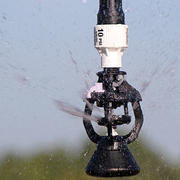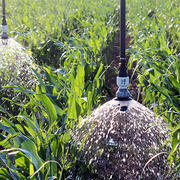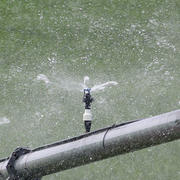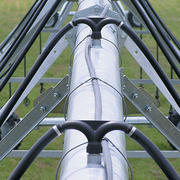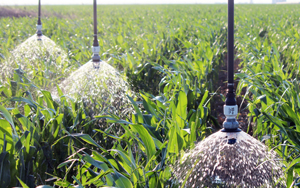
Irrigation efficiency is defined by a system’s ability to deliver the required amount of water to crops at the right time and place.
Regardless of the method that growers have employed―whether aged flood irrigation, overhead application or drip―they know that an efficient irrigation system greatly depends on the equipment and tools used, and on the strategies set in place to get the most out of it.
Leading manufacturers in the irrigation industry have developed a number of products to meet the need for more efficient agricultural practices and address the challenge of diminishing natural resources.
In other words, more food and fiber needs to be produced for a growing population, while water availability remains a major concern in many regions.
Leading Innovations
Center pivot and sprinkler manufacturers have also adopted new technologies to provide growers with more precise watering systems.
Among the advances that have contributed to irrigation development over the past decades, it is worth mentioning Wobbler® technology for overhead sprinklers.
This technology utilizes grooved deflectors to divide a flow into numerous streams of water but keeps them in a constant wobbling motion to further divide each stream into consistently sized droplets. This consistent droplet size is what helps maintain a sprinkler’s pattern integrity against wind-drift and evaporation.
The release of Wobbler technology™ launched a new generation of sprinklers noted for their low application intensity, great distribution uniformity, and large area of coverage at low pressures.
In nearly one hundred countries with diverse agricultural systems and geographical characteristics, Wobbler technology has proved its suitability when it comes to more efficient irrigation practices. Introduced by Senninger in 1978, there are now other manufacturers employing this concept as well.
The capability to use different grooved deflectors is one of the multiple advantages of this technology. It allows growers to customize their sprinkler’s droplet size and trajectory in order to best suit installation, crop and soil requirements. Typically, tighter soils require smaller droplets and looser soils can accept larger droplets.
Unlike stream-driven applicators, sprinklers based on the Wobbler concept offer the opportunity to deliver small, medium or larger droplets instantaneously over their entire wetted area.
Impact sprinklers deliver water in a more concentrated ring than can negatively impact the soil surface. They also produce many small droplets prone to wind-drift and evaporative loss, which lowers irrigation efficiency, and wastes water and energy. For their part, Wobbler sprinklers provide an even droplet size large enough to resist strong wind conditions, but not so large as to disrupt the soil.
Water-efficient sprinklers such as Wobblers, are now designed for low pressure operation (10 psi), allowing irrigators to achieve optimum performance, and lower total pumping costs by reducing horsepower requirements and energy consumption.
Low Pressures
Correct system pressure is key to assuring proper flow through emitters and optimum distribution uniformity. This helps prevent health issues and irregular growth.
Slight pressure fluctuations can produce dramatic flow changes. At low operating pressures of 7.98 to 29.9 psi, flow variations could easily exceed 10% with small changes in the system’s pressure.
This is true for both overhead sprinkler installations as well as drip installations that run at very low pressures of about 7.98 to 10 psi. A slight pressure variation on these low pressure systems can have a significant impact on application rates.
System pressures may vary due to elevation changes in a field, pressure loss through pipe fittings, or changes in the system’s water supply. On pivot irrigation systems they can also be altered by end guns cycling on and off.
Pressure regulators will help control these fluctuations and assure sprinklers distribution uniformity by limiting excess inlet pressure to a constant outlet pressure.
Top of Pipe
With new taller corn varieties, there is a renewed interest in top-of-pipe sprinklers on center pivots. Wobbler technology has also proved beneficial for this installation.
The newest sprinkler of the Wobbler family, the Xcel-Wobbler™ UP3® TOP, provides excellent distribution uniformity over a large area, making it ideal for high profile crops.
It is also suitable for varying terrains and for different types of soils due to its gentle rain-like application. Its instantaneous application over a large area reduces the impact of the sprinkler pattern, helping preserve the soil structure and its infiltration capabilities. This also helps prevent run-off and wheel tracking.
Close to the Ground
Many irrigators prefer their heads mounted on drops. Low Energy Precision Application (LEPA) and Low Elevation Spray Application (LESA) are two methods regaining popularity in North America.
Because they operate at lower pressures and deliver water closer to the ground, these methods combat wind-drift, save water, and even increase yields. Both technologies have also helped farmers reduce fuel consumption, and lower operating costs. LEPA has been used primarily for row crop irrigation with application efficiencies typically exceeding 95%.
Close Spacing is helping American growers save water and increase yields
Today, LEPA has evolved into close spacing installations where the sprinkler heads are placed just 30 inches apart, on every row, to wet the entire soil surface. In traditional LEPA systems, applicators are mounted far apart so they can irrigate every other furrow.
Close spacing combines the use of bubbler sprinklers with conservation tillage. Crop residues hold the water in place, allowing it to soak in and fill the soil profile.
In some cases, bubbler applicators deposit water directly into furrows, creating a narrow, aerated stream of bubbling water that resists high temperatures and strong winds. In other cases, they deflect water down in a wide, dome-shaped pattern that gently delivers the water without spraying, which is ideal for germination, low crop watering and sensitive soils that are prone to compaction.
With close spacing irrigation, American growers have seen approximately a 25% increase in water savings while also enjoying increased yields.
These benefits have created renewed interest in this type of irrigation practice, especially in areas where aquifer levels are declining or water is beginning to be regulated, or simply as a means to increase yields.
Growers are combining various components of this practice differently and achieving great success. They alter the spacing on the first few spans, combine spray application with bubble applications at various crop stages, vary the sprinkler height off the ground, and even alter the application rate by irrigation cycle.
For other irrigators, there is another powerful solution for issues they may face with run-off and surface sealing―which are often associated with clay soils with low infiltration rates.
Double goosenecks in combination with truss rod hose slings, allow the installation of two separate drops along a pivot span. Dividing the flow from a single outlet and delivering it on opposite sides of the mainline result in an increased wetted area using the same amount of water. This irrigation application can more closely match the soil’s intake rate for a better absorption of the water.
Combining double goosenecks with the wide pattern of Wobblers, further broadens the area of distribution which not only helps preserve the soil’s health, but also saves energy costs.
Source:
Published as "Efficient Irrigation from Top to Crop." Irrigazette International. September/October 2016.

